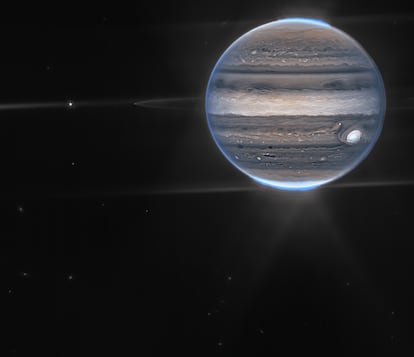The James Webb
Space Telescope
, a joint mission of NASA, ESA (European Space Agency) and CSA (Canadian Space Agency), has obtained new images of Jupiter, the largest planet in the Solar System that withstands temperatures, pressures, storms and winds ends.
The largest astronomical observatory ever launched into space has revealed details of the celestial body and its auroras, rings and satellites.
The two images released by NASA have been obtained with the near infrared camera (NIRCam), which has three specialized filters to capture this radiation invisible to the human eye.
In the final image, created from several shots taken by the telescope, the auroras stretch high above Jupiter's poles.
Webb
captures
also show clouds, mists, mists in the same regions.
More information
The first images from the 'James Webb' telescope
The Great Red Spot appears white in the images, like other clouds, due to the excessive reflection of sunlight.
This phenomenon is a massive storm with winds of up to 400 kilometers per hour and a diameter twice that of the Earth.
As explained by Heidi Hammel, an interdisciplinary scientist on the telescope mission, in a NASA statement, "the many bright white spots and streaks are probably high-altitude clouds of condensed convective storms."
Dark areas north of the equatorial region indicate less cloud presence.
Image of Jupiter with the moons Amalthea and Adrasthea to the left of the image.
The first is the most visible white dot and the second, less clear, is on the same line at the edge of the planet's rings.
/ NASA, ESA, CSA, Jupiter ERS Team
The most general view of Jupiter shows its rings and the moons Amalthea and Adrasthea.
The fuzzy spots in the lower background are probably galaxies.
Researchers have already begun analyzing Webb's data on the largest planet in the Solar System and the fifth furthest from the Sun.
You can follow
MATERIA
on
,
and
, or sign up here to receive
our weekly newsletter
.

